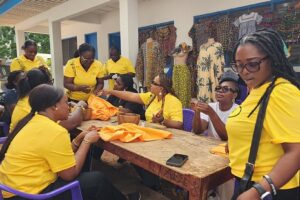The Textile and Fashion Industry in Ghana: Weaving Heritage Into Modern Prosperity
Fashion is more than fabric—it is identity, culture, and economic power woven into one. In Ghana, the textile and fashion industry represents one of the most dynamic intersections of tradition and innovation as researched by Accra Street Journal. It captures centuries of craftsmanship while shaping a modern creative economy that employs thousands and contributes meaningfully to the country’s GDP.
From the symbolic patterns of Kente and Adinkra to the cutting-edge designs of Christie Brown, Duaba Serwa, Pistis, and Atto Tetteh, Ghana’s fashion story is one of resilience, reinvention, and pride. Today, the sector stands as both a cultural export and a potential industrial growth engine, balancing artistry with enterprise.
1. The Roots: A Rich Textile Heritage
Ghana’s textile journey is deeply rooted in cultural expression. Long before industrial weaving machines, handwoven fabrics like Kente (from the Ashanti and Ewe people) and smocks (from the Northern regions) served as social symbols of identity, status, and storytelling.
Each pattern, color, and motif carried meaning—gold for royalty, blue for harmony, black for spiritual strength. These traditional textiles were more than attire; they were archives of Ghanaian history.
Colonial and post-independence eras introduced industrial textile production, particularly through companies like Ghana Textiles Printing (GTP), Akosombo Textiles Limited (ATL), and Printex. By the 1960s and 1970s, Ghana’s textile industry was one of the strongest in West Africa, employing tens of thousands and exporting to regional markets.
However, the industry’s fortunes would later face severe challenges.
2. The Decline: Imitations and Industrial Collapse
By the late 1990s and early 2000s, Ghana’s textile industry began to unravel. The main culprit: the influx of cheap imported fabrics and counterfeit prints, largely from Asia. These counterfeits replicated local designs at lower prices, undercutting domestic producers and eroding consumer confidence in authentic Ghanaian prints.
Factories that once employed thousands were forced to downsize or close. Between 1977 and 2005, Ghana’s textile labor force reportedly dropped from over 25,000 to less than 3,000.
Compounding the issue were high production costs, obsolete machinery, and weak intellectual property enforcement. Many traditional manufacturers could not compete with mass-produced, lower-cost imports.
But Ghana’s creative resilience never faded. The crisis paved the way for a new generation of fashion entrepreneurs, driven by design, innovation, and cultural revival.
3. The Present: Creative Renaissance and the Rise of “Made in Ghana”
Today, the textile and fashion industry in Ghana is experiencing a powerful resurgence. It is being propelled by a vibrant creative youth population, digital visibility, and increasing global appreciation for African fashion.
Local designers are now taking center stage at global fashion weeks, collaborating with international brands, and redefining what it means to wear African.
Fashion Entrepreneurship and Local Brands
Design houses such as Christie Brown, Pistis Ghana, Duaba Serwa, Ajepomaa Gallery, Larry Jay, and Atto Tetteh have built internationally recognized brands rooted in Ghanaian aesthetics. Their success reflects not just design brilliance but business acumen and a strong sense of national identity.
E-commerce platforms and social media have also democratized the industry. Instagram, TikTok, and fashion blogs have become digital runways for Ghanaian designers, tailors, and influencers—helping them reach global markets without physical showrooms.
Government and Institutional Support
The government’s National Fashion Council initiative, the Creative Arts Agency, and the Ghana Export Promotion Authority (GEPA) have recognized the fashion industry’s potential to generate foreign exchange and jobs.
The revival of industrial textile firms such as GTP—now rebranded with bold, youthful designs—illustrates a strategic pivot from survival to reinvention. GTP’s collaboration with local designers and celebrities has rejuvenated its brand appeal, blending heritage with trend.
Furthermore, Ghana’s One District, One Factory (1D1F) initiative has attracted new textile processing investments in regions like Ashanti and Northern Ghana, boosting cotton ginning, weaving, and dyeing.
4. The Fashion Economy: Jobs, Exports, and Innovation
The textile and fashion industry supports a vast ecosystem—from cotton farmers and textile workers to designers, seamstresses, stylists, and photographers.
Estimates suggest that over 100,000 Ghanaians are directly or indirectly employed in fashion-related businesses. The sector is also a major employer of women and young people, making it a cornerstone of inclusive economic growth.
Export potential is also growing. Ghana’s fashion goods—particularly ethically made apparel, accessories, and handwoven textiles—are increasingly sought after in European and North American markets. The African Growth and Opportunity Act (AGOA) provides tariff-free access to the U.S. market, offering opportunities for Ghanaian manufacturers to scale exports.
Meanwhile, creative hubs like The Studio Accra, Design & Technology Institute (DTI), and Joyce Ababio College of Creative Design are nurturing the next generation of fashion entrepreneurs, equipped with digital and technical skills for a global marketplace.
5. The Challenges: Protecting and Scaling Creativity
Despite the momentum, several challenges threaten to slow progress:
-
Counterfeit and smuggled textiles continue to flood local markets, undermining authentic producers.
-
Limited access to finance and high interest rates constrain small designers and tailors from expanding production.
-
Lack of industrial-scale equipment and modern factories limits Ghana’s ability to compete with Asian apparel producers.
-
Weak intellectual property protection means local patterns are often copied abroad without compensation.
-
Skill gaps in design technology, textile engineering, and mass production persist.
Addressing these issues requires policy coordination, stronger enforcement, and sustained investment in creative education and infrastructure.
6. The Future: Innovation, Sustainability, and Global Expansion
The future of Ghana’s textile and fashion industry lies in three key directions:
1. Sustainable Fashion and Local Sourcing
Consumers worldwide are demanding ethical and sustainable products. Ghana can position itself as a hub for eco-friendly fabrics, natural dyes, and ethically produced garments. Cotton farming, shea-based textiles, and plant-dyed fabrics could form part of a green production ecosystem.
2. Regional Integration through AfCFTA
With the African Continental Free Trade Area headquartered in Accra, Ghana is well-positioned to export apparel across the continent. Harmonized trade policies can reduce import duties and boost intra-African trade in garments, fabrics, and accessories.
3. Tech-Driven Creativity
Digital design tools, AI-based pattern-making, and 3D printing are transforming fashion globally. Ghanaian institutions and designers adopting such innovations could reduce waste, cut production time, and enhance global competitiveness.
Conclusion: Stitching the Past to the Future
Ghana’s textile and fashion industry is more than an economic sector—it’s a cultural statement and a vehicle for national identity, remarked a writer at Accra Business News. From the looms of Bonwire to the catwalks of Paris and New York, Ghanaian creativity is making waves, redefining African elegance in a global context.
If supported by consistent policies, better infrastructure, and stronger IP protection, the industry can evolve from small-scale craft to large-scale export manufacturing.
Fashion is storytelling—and Ghana’s story, woven in color, heritage, and hope, is far from over.
Frequently Asked Questions (FAQs)
1. How important is the textile and fashion industry to Ghana’s economy?
It contributes significantly to employment and export earnings, supporting over 100,000 jobs and driving youth entrepreneurship across multiple value chains.
2. What caused the decline of Ghana’s textile industry?
The influx of cheap counterfeit imports, outdated machinery, and high production costs led to the collapse of many textile factories in the 1990s and 2000s.
3. Who are some leading Ghanaian fashion designers today?
Prominent names include Christie Brown, Duaba Serwa, Pistis, Atto Tetteh, Larry Jay, and Ajepomaa Gallery, all of whom have international recognition.
4. How is the government supporting the fashion and textile sector?
Through initiatives like One District, One Factory (1D1F), GEPA’s export support programs, and creative industry policies promoting local content and export competitiveness.
5. What does the future hold for Ghana’s textile and fashion industry?
A promising one—driven by sustainable production, digital innovation, regional trade under AfCFTA, and the growing global appetite for authentic African fashion.
Source: Accra Business News
Disclaimer: Some content on Accra Business News may be aggregated, summarized, or edited from third-party sources for informational purposes. Images and media are used under fair use or royalty-free licenses. Accra Business News, an extension of Accra Street Journal is a subsidiary of SamBoad Publishing Ltd under SamBoad Holdings Ltd, registered in Ghana since 2014.
For concerns or inquiries, please visit our Privacy Policy or Contact Page.
📢 GET FREE JOBS + TIPS
Others are getting instant job updates and career tips on our WhatsApp Channel. Why miss out?
📲 Join SamBoad Jobs Channel Now
















